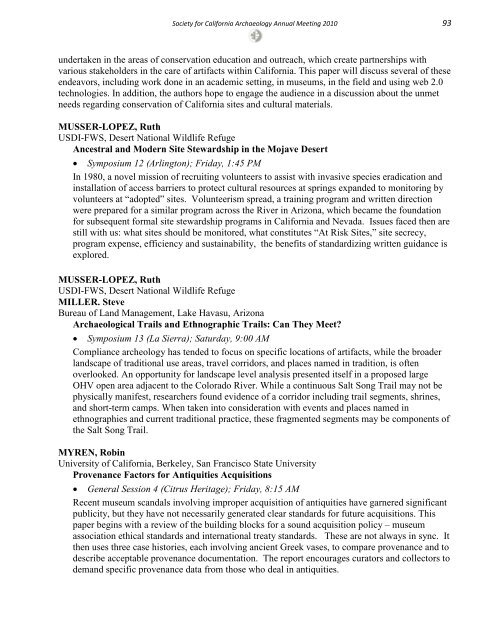Society for California Archaeology 2010 Annual Meeting
Society for California Archaeology 2010 Annual Meeting
Society for California Archaeology 2010 Annual Meeting
You also want an ePaper? Increase the reach of your titles
YUMPU automatically turns print PDFs into web optimized ePapers that Google loves.
<strong>Society</strong> <strong>for</strong> Cali<strong>for</strong>nia <strong>Archaeology</strong> <strong>Annual</strong> <strong>Meeting</strong> <strong>2010</strong> 93<br />
undertaken in the areas of conservation education and outreach, which create partnerships with<br />
various stakeholders in the care of artifacts within Cali<strong>for</strong>nia. This paper will discuss several of these<br />
endeavors, including work done in an academic setting, in museums, in the field and using web 2.0<br />
technologies. In addition, the authors hope to engage the audience in a discussion about the unmet<br />
needs regarding conservation of Cali<strong>for</strong>nia sites and cultural materials.<br />
MUSSER-LOPEZ, Ruth<br />
USDI-FWS, Desert National Wildlife Refuge<br />
Ancestral and Modern Site Stewardship in the Mojave Desert<br />
• Symposium 12 (Arlington); Friday, 1:45 PM<br />
In 1980, a novel mission of recruiting volunteers to assist with invasive species eradication and<br />
installation of access barriers to protect cultural resources at springs expanded to monitoring by<br />
volunteers at “adopted” sites. Volunteerism spread, a training program and written direction<br />
were prepared <strong>for</strong> a similar program across the River in Arizona, which became the foundation<br />
<strong>for</strong> subsequent <strong>for</strong>mal site stewardship programs in Cali<strong>for</strong>nia and Nevada. Issues faced then are<br />
still with us: what sites should be monitored, what constitutes “At Risk Sites,” site secrecy,<br />
program expense, efficiency and sustainability, the benefits of standardizing written guidance is<br />
explored.<br />
MUSSER-LOPEZ, Ruth<br />
USDI-FWS, Desert National Wildlife Refuge<br />
MILLER. Steve<br />
Bureau of Land Management, Lake Havasu, Arizona<br />
Archaeological Trails and Ethnographic Trails: Can They Meet?<br />
• Symposium 13 (La Sierra); Saturday, 9:00 AM<br />
Compliance archeology has tended to focus on specific locations of artifacts, while the broader<br />
landscape of traditional use areas, travel corridors, and places named in tradition, is often<br />
overlooked. An opportunity <strong>for</strong> landscape level analysis presented itself in a proposed large<br />
OHV open area adjacent to the Colorado River. While a continuous Salt Song Trail may not be<br />
physically manifest, researchers found evidence of a corridor including trail segments, shrines,<br />
and short-term camps. When taken into consideration with events and places named in<br />
ethnographies and current traditional practice, these fragmented segments may be components of<br />
the Salt Song Trail.<br />
MYREN, Robin<br />
University of Cali<strong>for</strong>nia, Berkeley, San Francisco State University<br />
Provenance Factors <strong>for</strong> Antiquities Acquisitions<br />
• General Session 4 (Citrus Heritage); Friday, 8:15 AM<br />
Recent museum scandals involving improper acquisition of antiquities have garnered significant<br />
publicity, but they have not necessarily generated clear standards <strong>for</strong> future acquisitions. This<br />
paper begins with a review of the building blocks <strong>for</strong> a sound acquisition policy – museum<br />
association ethical standards and international treaty standards. These are not always in sync. It<br />
then uses three case histories, each involving ancient Greek vases, to compare provenance and to<br />
describe acceptable provenance documentation. The report encourages curators and collectors to<br />
demand specific provenance data from those who deal in antiquities.

















